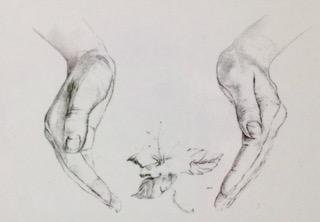by Beth
Young Italian Girl Resting by Paul Cezanne
According to the Mayo Clinic nearly everyone is overtired or overworked from time to time. Unrelenting fatigue is a whole different matter. When fatigue lasts longer, is more profound, and isn't relieved by rest, it’s a sure sign that you need to see a medical professional. Temporary fatigue, on the other hand, usually has an identifiable cause and a likely remedy. What are some likely causes? Here’s their suggested list: - Use of alcohol or drugs
- Excess physical activity
- Jet lag
- Lack of physical activity
- Lack of sleep
- Medications, such as antihistamines, cough medicines
- Unhealthy eating habits
To the Mayo Clinic’s list I would add one more: dealing with energy draining, stressful situations like: personal relationships, chronic physical conditions, mental/emotional difficulties, finances, dealing with difficult people, and others (fill in the blank with your own). I, myself, am coming out of a period of temporary fatigue. In other words I was experiencing a couch potato, empty vessel, sloth-like, lack of energy. Temporary fatigue typically hits me after a long period of “fast forward” activity, and looking back over the past two months, I can pinpoint the causes. If I’m brutally honest they are: - Lack of sleep. Thankfully not insomnia, but just staying up late and hanging out past my optimal bedtime of 10:30 p.m.
- Unhealthy eating habits. Too many carbs, mostly in the form of bread. It’s my go-to comfort food but overeating it is clearly a factor in my personal fatigue formula.
- Excess activity; The biggest piece of this was preparing for and delivering an 8-hour long workshop on a new topic in addition to the holidays and my other teaching, volunteer, and domestic responsibilities.
Albert Einstein said, “Energy cannot be created or destroyed, it can only be changed from one form to another.” Right on, Albert! So that means phrases like “lack of energy” or “I have no energy” are not entirely accurate. We do have energy but sometimes there can be a need to change its form from a shortage into a surplus. In other words, we need to find ways to “light our fire” or “get the lead out,” and bring our energy up. Here are two ways to accomplish that goal. 1. Take a Day Off Why do I recommend taking a rest day? Here’s my reasoning: Rest days are written into training plans for athletes, even those training for the Olympics, to allow the body to recuperate. You can literally take the day off from yoga practice or take a just break from active yoga practice. To take a day off completely, use your practice time to hang out, rest, relax, catch up on your reading, or do nothing. If you’d like to use your yoga practice as a way to rest, practice your favorite restorative yoga poses and/or techniques (see Restorative Yoga by Nina). 2. Converting Energy From Shortage to Surplus Sometimes, we need a technique or two to get our energy up in order to function until that precious day off can get scheduled. To use your yoga practice as a change agent, you do not necessarily have to change what you do, just change how you do it. Practice your postures in a way that creates heat, and encourages feelings of stimulation, intention, and intensity. But keep the following advice in mind: - Be sure to warm up first.
- Focus on the feeling of moving purposefully between postures.
- Focus more on your inhalations.
- Move with strength, speed, determination, and intensity.
- Build towards a longer, stronger practice that is within your capability.
Here’s a technique you may not be familiar with: The Breath of Joy. It’s typically done in a standing position but is easily modified for sitting in a chair. It’s from the Kripalu Yoga tradition and the instructions below are from a Yoga International article by Amy Weintraub The Breath of Joy (Amy is the author of Yoga for Depression, founder of the LifeForce Yoga Healing Institute, and a leader in the field of yoga and mental health). Caution: This practice may not be appropriate for those with high blood pressure or who suffer from eye or head injuries. The purpose of The Breath of Joy is to awaken the whole system, increasing oxygen levels in the bloodstream, temporarily stimulating the sympathetic nervous system, and focusing the mind. Just what I need to get my energy up! Here are Amy’s instructions: “To practice Breath of Joy, stand with your feet shoulder-width apart and parallel, knees slightly bent.
1. Inhale one-third of your lung capacity and swing your arms up in front of your body, bringing them parallel to each other at shoulder level, with palms facing the ceiling. 2. Continue inhaling to two-thirds capacity and stretch your arms out to the side like wings to shoulder level. 3. Inhale to full capacity and swing your arms parallel and over your head, palms facing each other. 4. Open your mouth and exhale completely with an audible ha, bending the knees more deeply as you sink into a standing squat and swing your arms down and back behind you like a diver. Repeat up to nine times. Don’t force or strain the body or breath; simply be absorbed by the peacefully stimulating rhythm. Return to standing. Close your eyes and experience the effects. Notice how quickly your heart beats; feel the sensations in your face and arms, and the tingling in the palms of your hands."Some examples of pranayama and mudra practices you might try are: Kapalabhati breath, (see Stimulating Breath Practices We Recommend or Vittam mudra from Mudras for Healing and Transformation by Joseph and Lilian LePage. Vittam mudra helps to establish the free flow of vital energy. Instructions for Practicing Vittam Mudra- Sit with your spine comfortably aligned.
- Soften your chest and shoulders.
- Close your eyes or keep them slightly open and gaze down at the floor.
- Hold your hands cupped in front of your lower abdomen with palms facing each other about twelve inches apart.
- Allow your hands to naturally part away from each other on the inhalation and rest gently back toward each other on the exhalation.
- Repeat for 5 to 10 long, deep breaths or more, as long as you are comfortable.
Our energetic needs are like fingerprints; no two people are alike. These techniques work for me, which is why I am sharing them. Will they work for you? Try them out and see.Subscribe to Yoga for Healthy Aging by Email ° Follow Yoga for Healthy Aging on Facebook ° Join this site with Google Friend Connect



